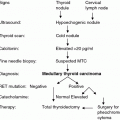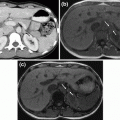ret codon A/A change in MEN2 syndromes
ATA risk level
Primary hyperparathyroidism
C609F/R/G/S/Y
B
C611R/G/F/S/W/Y
B
C618R/G/F/S/Y
B
C620R/G/F/S/W/Y
B
C630R/F/S/Y
B
Rare
D631Y
B
Rare
633/9 base pair duplication
B
C634R
C
C634G/F/S/W/Y
C
C634Y/Y791F
Rare
634/12 base pair duplication
B
S649L
A
Rare
E768D
A
Rare
L790F
A
Rare
Y791F
A
V804L
A
V804M
A
Rare
V804M+S904Cc,d
D
S891A
A
R912P
A
4 Diagnosis
The diagnosis of PHP in MEN2 does not differ from that in the sporadic form of the disease. Calcium levels corrected for albumin are abnormally elevated, and serum phosphate may be low. Parathyroid hormone measurement will confirm the diagnosis in case of hypercalcemia. Secondary hyperparathyroidism, usually due to vitamin D deficiency, should be excluded before the diagnosis of PHP can be made. This is also recommended in the European Thyroid Association Guidelines (Elisei et al. 2012). Localization studies include high-resolution ultrasound by an experienced observer and parathyroid scan using sestamibi. As in other cases of PHP, when the disease is asymptomatic, it is important to investigate whether any of the complications accompanying PHP are present, such as hypercalciuria, nephrolithiasis, and osteoporosis. When the diagnosis of PHP is made before that of MTC, a combined thyroidectomy parathyroidectomy is performed (Elisei et al. 2012).
5 Treatment
MEN2 associated PHP is usually benign. The treatment of PHP is surgical. The decision on the surgical procedure to be followed is important because recurrence or persistence of disease may occur in cases where multiple gland involvement may go unnoticed. In the management of PHP in MEN syndromes in general, it is important to recognize single gland versus multiple gland involvement. Removal only of the enlarged glands is usually associated with good results (Kraimps et al. 1996; Dotzenrath et al. 2001; O’Riordain et al. 1993; Scholten et al. 2011). Over the years, several surgical procedures have been applied for the management of PHP, and these have recently been reviewed (Scholten et al. 2011). In some centers, the parathyroidectomy is performed together with the initial surgery for MTC (Scholten et al. 2011; Yoshida et al. 2009).
The surgical procedures that have been used are as follows: total parathyroidectomy with autotransplantation, subtotal parathyroidectomy, single-gland removal, or removal of only enlarged glands. The procedure to be followed depends on the number of glands apparently involved. As in other cases of PHP, the skills of the surgeon are of importance and high-volume surgeons should be undertaking the parathyroidectomy. Because of the possible involvement of multiple glands, all parathyroids should be identified during the operation. Results after surgery for PHP from various centers are shown in Table 2.
Table 2
Recurrence/persistence of disease after surgery performed for primary hyperparathyroidism (PHP) in MEN2 syndrome according to the type of operation
Type of parathyroidectomy | |||||
|---|---|---|---|---|---|
Author (year) | n | Follow-up (years) | Selective | Subtotal | Total |
O’Riordain et al. (1993) | 18 | 5.8 | 0/9 | 0/7 | 0/2 |
Raue et al. (1995) | 60 | 8 | 4/28 (14) | 2/21 (9) | 2/11 (18) |
Herfarth et al. (1996) | 34 | 11.4 | 6/21 (29) | 2/8 (25) | 0/5 |
Kraimps et al. (1996) | 56 | 6.4 | 6/29 (21) | 3/12 (25) | 1/11 (9) |
Dotzenrath et al. (2001) | 7 | 3.5 | 2/5 (40) | 0/1 | 0/1 |
Scholten et al. (2011)
Stay updated, free articles. Join our Telegram channel
Full access? Get Clinical Tree
 Get Clinical Tree app for offline access
Get Clinical Tree app for offline access

| |||||





